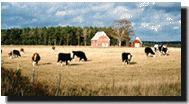
As of 1997, there were 592 beef producing farms on the
Island. Most beef operations on the Island have been part
of mixed family farms for a long time, but increasing
numbers of farms are beginning to specialize in beef. The
feedlot industry is the most developed sector of the
Island beef industry, thanks in large part to our
excellent soil quality—our grain producers grow
high-quality forage and our thriving potato industry
provides an abundant supply of cull potatoes for
finishing feeder cattle. The Island’s feedlot
industry depends on local dairy and beef calves as well
as calves brought in from New Brunswick and Nova Scotia.
Figures fluctuate from year to year due to changes in
supply and prices for beef, but in 1990, it was said that
Island beef producers annually sent about 35,000 head of
cattle for slaughter.
The cow and calf industry is comprised
of purebred and commercial productions. Island purebred
beef producers are reputed for their genetically superior
breeding stock. Commercial cow and calf farmers raise
calves from spring birth until fall weaning. These calves
are then sold to feedlots or remain on the farm to grow
and fatten out until they are slaughtered. The most
popularly farmed  cattle are of traditional British
breeding which make excellent “maternal” brood
cows. These are the Herefords, Aberdeen Angus, and
Shorthorns. Continental, “exotic” breeds such
as Simmental, Charolais, and Limousin are also quite
popular, first coming to the Island in the 1970s. They
are best known for their rapid growth.
cattle are of traditional British
breeding which make excellent “maternal” brood
cows. These are the Herefords, Aberdeen Angus, and
Shorthorns. Continental, “exotic” breeds such
as Simmental, Charolais, and Limousin are also quite
popular, first coming to the Island in the 1970s. They
are best known for their rapid growth.
Most animals, weighing 1,200 to 1,400 pounds, are sold to
one of two federally inspected slaughterhouses: Garden
Province Meats in Charlottetown, Prince Edward Island, or
Hub Meat Packers in Moncton, New Brunswick.
 Dairy farming is a very stable and
profitable agricultural activity in Prince Edward Island.
It is second only to potatoes in generating farm revenue.
In 1997, there were 337 dairy farms in the province.
Various farms among this group produce fluid milk sold
for drinking, cream used for making butter, and
industrial milk that is processed to manufacture products
such as evaporated milk, cheese, ice cream, and powdered
milk. When it comes to milk production, Prince Edward
Island is highly industrialized. Approximately 85 percent
of the milk produced on the Island is processed into
industrial milk products. In the other Maritime
Provinces, by contrast, industrial milk represents 35
percent to 40 percent of total production.
Dairy farming is a very stable and
profitable agricultural activity in Prince Edward Island.
It is second only to potatoes in generating farm revenue.
In 1997, there were 337 dairy farms in the province.
Various farms among this group produce fluid milk sold
for drinking, cream used for making butter, and
industrial milk that is processed to manufacture products
such as evaporated milk, cheese, ice cream, and powdered
milk. When it comes to milk production, Prince Edward
Island is highly industrialized. Approximately 85 percent
of the milk produced on the Island is processed into
industrial milk products. In the other Maritime
Provinces, by contrast, industrial milk represents 35
percent to 40 percent of total production.
 The
most popular breeds of dairy cattle on the Island are
Holsteins followed by Ayshires, Guernsey, Jersey, and
Brown Swiss. Generally, Island farms supplying cream for
butter are small operations where dairying is a sideline.
Industrial and fluid milk producers tend to be engaged in
larger, more intensive operations and are showing signs
of increased revenue. Indeed, milk production per cow and
overall quality and quantity is increasing while the
total number of dairy operations is decreasing.
The
most popular breeds of dairy cattle on the Island are
Holsteins followed by Ayshires, Guernsey, Jersey, and
Brown Swiss. Generally, Island farms supplying cream for
butter are small operations where dairying is a sideline.
Industrial and fluid milk producers tend to be engaged in
larger, more intensive operations and are showing signs
of increased revenue. Indeed, milk production per cow and
overall quality and quantity is increasing while the
total number of dairy operations is decreasing.
The dairy industry in Canada is highly regulated and
Prince Edward Island’s portion of the national quota
is administered and distributed among local farmers by
the Prince Edward Island Milk Marketing Board.
Potatoes | Fruits and Vegetables |
Field Crops | Swine
Poultry and Eggs | Emerging Commodities |
Beekeeping
